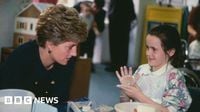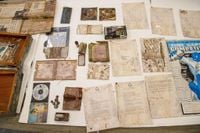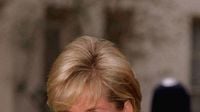For more than three decades, a small lead-encased wooden box sat quietly beneath the main entrance of London’s Great Ormond Street Hospital (GOSH), its secrets sealed away by none other than Princess Diana. Now, in 2025, as construction begins on a cutting-edge children’s cancer center, the time capsule has finally been unearthed—offering a rare, almost cinematic glimpse into the world of 1991 and the enduring legacy of the “People’s Princess.”
The opening of the capsule, just days before the 28th anniversary of Diana’s tragic death, has drawn a wave of nostalgia and reflection. According to ABC News, Jason Dawson, GOSH’s executive director, described the moment as “really quite moving, almost like connecting with memories planted by a generation gone by.” The artifacts inside—many battered by the passage of time—paint a vivid portrait of early-90s Britain and Diana’s unique approach to charity.
So, what treasures lay hidden for 34 years? The selection was as eclectic as it was symbolic. There was a Casio pocket television—then the height of portable tech—alongside a solar-powered calculator, a vial of tree seeds from Kew Gardens, and a hologram snowflake. Most notably, a Kylie Minogue CD, specifically the singer’s third studio album “Rhythm of Love,” was included. Released in 1990, the album featured hits like “Better the Devil You Know” and “Step Back In Time,” and was chosen by David Watson, then 11 years old, from Paignton, Devon. Watson also selected a European passport, a sheet of recycled paper, and the aforementioned pocket TV, all meant to represent the era’s technological and cultural spirit.
Meanwhile, Sylvia Foulkes, then 9, from Norwich, contributed a collection of British coins—up to the value of £1 to mark the 20th anniversary of decimalisation—along with the tree seeds and hologram. Both Watson and Foulkes had won a national competition hosted by the BBC’s Blue Peter, which asked children to select items that best captured life in the 1990s. According to BBC News, Princess Diana herself helped the young winners choose the final contents, lending her own photograph and a copy of The Times newspaper from the day the capsule was buried. The headlines on that edition included “Cooked meats bring out Soviet voters in droves” and “US rejects Iraqi warplanes plea as rebels close in”—a reminder of the turbulent global landscape of the time.
The capsule’s burial in March 1991 marked the laying of the foundation stone for GOSH’s Variety Club Building, which opened in 1994. The ceremony echoed a tradition dating back to 1872, when Princess Alexandra, then Princess of Wales, sealed a similar time capsule (which, incidentally, has never been found). As the Daily Mail reports, staff who were either born in 1991 or already working at the hospital helped carefully remove Diana’s capsule, underscoring the sense of generational continuity at GOSH.
Some objects had suffered from moisture over the years, but most remained remarkably intact. Images released by hospital archivists show the rusted but still recognizable pocket TV, a slightly tarnished Kylie Minogue CD, and the crinkled but legible newspaper. For Janet Holmes, a senior health play specialist at GOSH who was working there in 1991, the pocket TV was a particular favorite. “It brought back so many memories seeing the pocket TV in there,” she said. “I had bought one for my husband back in the day, for when he had a break whilst driving his coach around the country. They were very expensive then!” (Daily Mail)
But the story of the capsule is just as much about Princess Diana herself as it is about the objects it held. Diana became president of GOSH in 1989 and remained deeply involved with the hospital until her death in 1997. She was a regular presence on the wards, often sitting on children’s beds, holding hands, and offering the kind of comfort that, at the time, many public figures shied away from. As ABC News points out, Diana’s approach to charity was deeply personal and hands-on, “probably more significant than any other person’s in the 20th century,” according to Stephen Lee, director of the UK Institute of Charity Fundraising Managers.
Her impact was more than symbolic. Diana spearheaded the hospital’s Wishing Well Appeal, raising £54 million—equivalent to £200 million today—making it the largest UK charity appeal of its era. After her divorce from Prince Charles in 1996, Diana narrowed her focus to just six causes, with GOSH remaining one of her chosen organizations. Her legacy, many argue, helped push the British monarchy into the modern age. Emma Hart of the University of Pennsylvania told ABC News that Diana “forced the British monarchy to move into the 21st century” and “showed how the royal family could be a force for good.” Today, that legacy lives on in the philanthropic work of her sons, Prince William and Prince Harry.
The capsule’s early unearthing was prompted by progress on GOSH’s new children’s cancer center, a project aiming to transform pediatric cancer care in the UK. The hospital says the center, scheduled to open in 2028, will increase patient capacity by 20% and serve as a national resource for the treatment of childhood cancers. According to a statement from GOSH cited by BBC News, the facility will focus on research and innovation, with a design “developed with families and clinicians” to create “kinder, more effective treatments, all delivered in a child-focused environment where children can play, learn and be with their family while at hospital.”
This new chapter for GOSH is, in many ways, a testament to Diana’s vision and the values she championed. The hospital’s commitment to child-centered care and medical innovation echoes the spirit of the time capsule—a collection of objects chosen not just for their novelty, but for what they might say to future generations about compassion, progress, and hope.
As the dust settles on the capsule’s contents, one can’t help but wonder what stories the next generation will choose to preserve. For now, though, the artifacts from 1991 serve as a poignant reminder of a remarkable woman’s enduring influence—and the ever-evolving story of a hospital at the heart of Britain’s care for its youngest patients.


